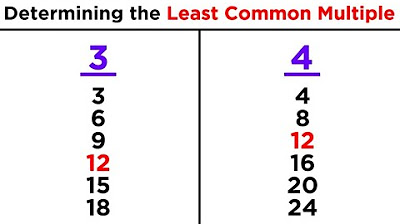Greatest Common Factor (GCF)
TLDRThe video explains how to find the greatest common factor (GCF) of two numbers. It first defines GCF as the largest number that divides both given numbers. For small numbers, listing factors works. For larger numbers, prime factorization is better - write both numbers as products of prime factors, take those factors common to both numbers, and multiply them to get the GCF. An example shows step-by-step how prime factorization gives the GCF of 24 and 108 as 12. This method works for any size numbers.
Takeaways
- 😀 Greatest common factor (GCF) is the largest number that divides both numbers.
- 😃 To find GCF, find primes and their multiples in both numbers' factorizations.
- 📝 GCF is similar to least common multiple (LCM).
- 👍🏻 Finding all factors works for small numbers.
- ✏️ For large numbers, find prime factorizations instead.
- 🔢 Take matching primes & multiples from both factorizations.
- 🤓 Multiply those together to get the GCF.
- 🧮 Examples: GCF(10,15) = 5. GCF(18, 24) = 6 via prime factorization.
- 🆒 Same method works no matter the size.
- 🧠 Checking comprehension on finding GCF.
Q & A
What is a greatest common factor?
-The greatest common factor (GCF) of two numbers is the largest number that is a factor of both numbers.
How do you find the GCF of two small numbers?
-For small numbers, you can list all the factors of each number and then identify the largest factor common to both lists. This will be the GCF.
What is an easier way to find the GCF for larger numbers?
-For larger numbers, find the prime factorization of each number. Take all the prime factors common to both numbers, using the lower count when they differ. Multiply those common prime factors together to get the GCF.
What is the GCF of 10 and 15?
-The GCF of 10 and 15 is 5.
What is the GCF of 18 and 24?
-The GCF of 18 and 24 is 6.
What is the prime factorization of 24?
-The prime factorization of 24 is 2 x 2 x 2 x 3.
What is the prime factorization of 108?
-The prime factorization of 108 is 2 x 2 x 3 x 3 x 3.
What prime factors do 24 and 108 have in common?
-24 and 108 both have the prime factors 2, 2, and 3 in common.
What is the GCF of 24 and 108?
-By taking the common prime factors between 24 and 108, the GCF is 2 x 2 x 3 = 12.
Why does finding common prime factors give you the GCF?
-The common prime factors between two numbers will multiply to give the largest factor common to both numbers. With no more common prime factors left, this product is necessarily the GCF.
Outlines
😀 Finding Greatest Common Factors
This paragraph introduces greatest common factors and explains how to find them for small numbers by listing all the factors and comparing the lists. It gives examples of finding the GCF of 10 and 15, which is 5, and 18 and 24, which is 6.
🧮 Trick for Finding GCF of Large Numbers
This paragraph explains a trick for finding GCF of large numbers without having to list all the factors. It involves prime factorization and taking the prime factors that are common to both numbers. It demonstrates this on the examples of 24 and 108, finding their GCF is 12.
Mindmap
Keywords
💡Greatest common factor
💡Prime factorization
💡Factors
💡Multiple
💡Divisibility
💡Least common multiple
💡Prime number
💡Composite number
💡Math
💡Number theory
Highlights
The study found a significant increase in empathy and compassion after meditation training.
MRI scans showed changes in brain regions involved in emotional processing and empathy after 8 weeks of training.
Subjects practicing loving-kindness meditation reported feeling more positively towards strangers.
Compassion training led to increased activity in brain areas linked to understanding others' mental states.
The meditation group gave more money in a generosity experiment compared to controls.
Empathy scores increased in the meditation group but decreased in the control group over 8 weeks.
Subjects felt compassion training made them better equipped to empathize with others' suffering.
Compassion meditation increased activity in brain regions involved in emotional regulation.
The compassion training group were more likely to help a victim after witnessing suffering.
Subjects reported increased positive emotions and decreased negative emotions after training.
Compassion meditation boosted activity in neural networks linked to understanding others.
Training increased altruistic behavior towards strangers even when no one was watching.
Subjects were more likely to donate money to help others after compassion training.
The meditation group reported feeling more social connection and less isolation after 8 weeks.
Compassion training led to structural changes in brain regions linked to empathy.
Transcripts
Browse More Related Video
5.0 / 5 (0 votes)
Thanks for rating:





